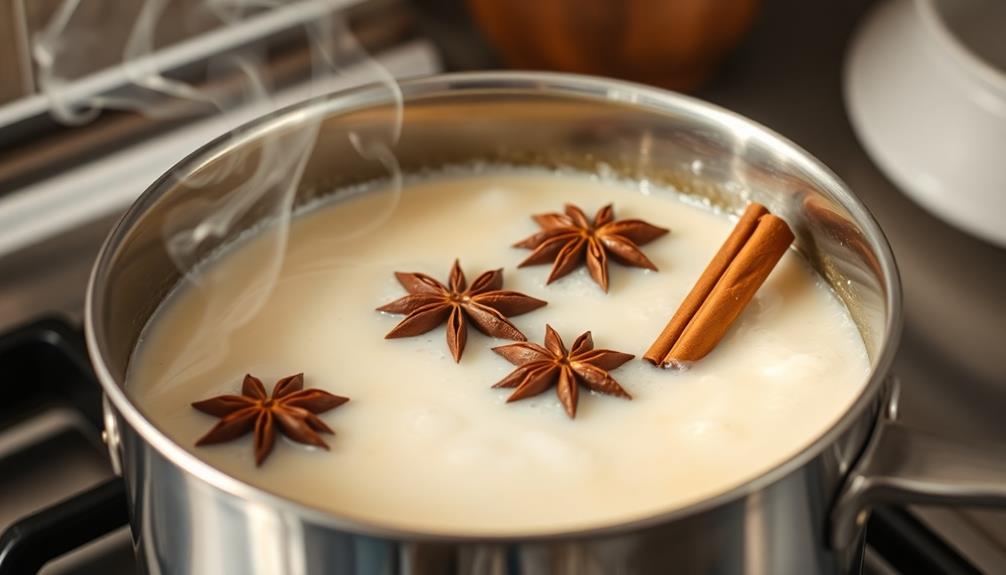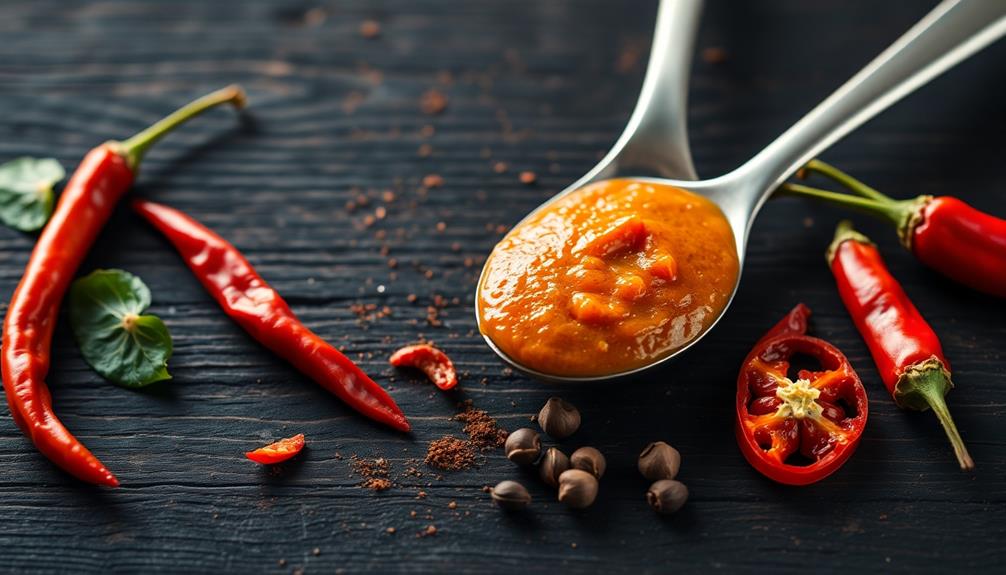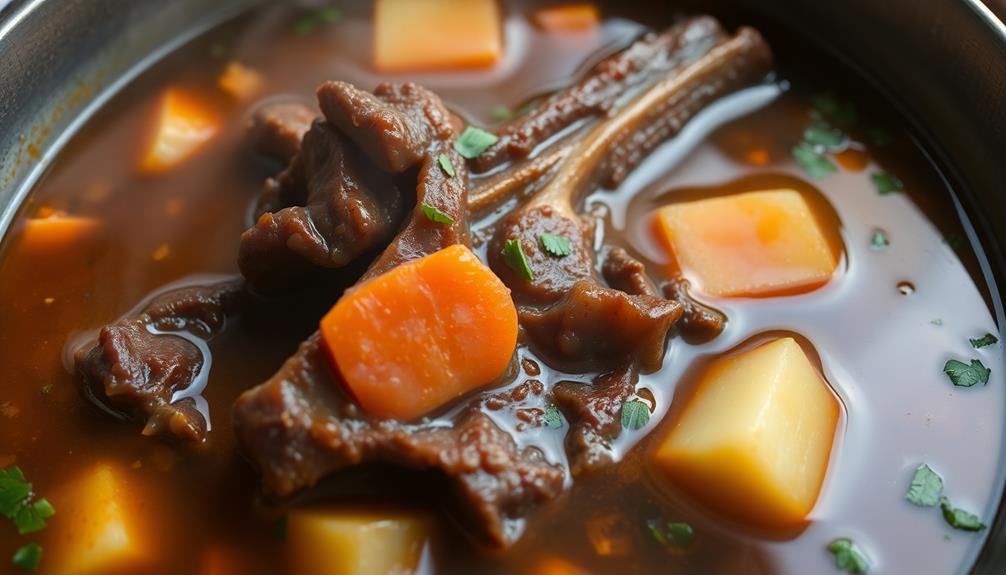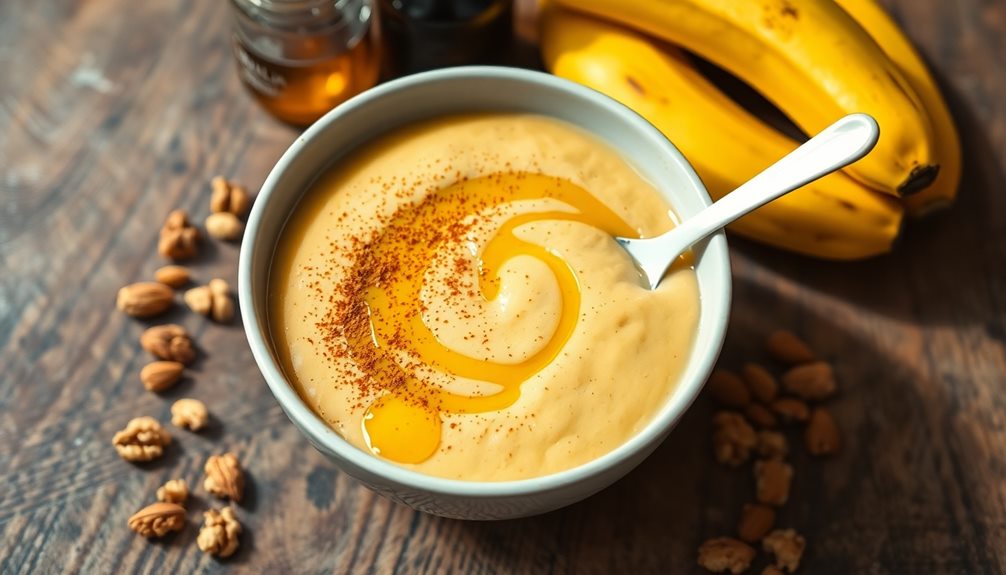Laksa, the beloved spicy noodle soup from Southeast Asia, combines a rich coconut-based broth with chewy rice noodles, succulent seafood, and a medley of aromatic herbs and spices, creating a flavor-packed culinary experience that has captivated taste buds across the region. This iconic dish reflects the vibrant street food culture, offering a comforting connection through shared traditions and flavors. Whether you prefer a fiery kick or a milder touch, laksa invites you to savor each slurp, exploring the endless possibilities of ingredient variations and regional specialties. Get ready to embark on a sensory journey that will leave you craving more.
Key Takeaways
- Laksa is a spicy, coconut-based noodle soup from Peranakan cuisine, known for its fragrant and flavorful profile.
- Laksa represents a blend of Malay and Chinese culinary traditions, showcasing the rich cultural heritage of Southeast Asia.
- The dish features a carefully crafted paste of aromatic spices and herbs as the key to its delicious flavor.
- Laksa can be customized with varying spice levels and ingredients, encouraging creativity and experimentation.
- Enjoying laksa is a sensory experience, inviting diners to savor each slurp and appreciate the complex taste profiles.
History
Originating from the Peranakan culture, a unique blend of Malay and Chinese traditions, laksa has a rich history that dates back centuries.
This beloved dish has evolved over time, with various regional variations emerging across Southeast Asia. In Malaysia, laksa is a culinary treasure, showcasing the country's diverse cultural influences.
The roots of laksa can be traced to the Peranakan communities, who combined the spices and techniques of Malay and Chinese cuisines. Over the years, local chefs have put their own spin on the dish, resulting in the myriad of laksa styles found today.
From the tangy and coconut-infused Asam laksa of Penang to the rich and creamy Katong laksa of Singapore, each region has its own distinct take on this flavorful noodle soup.
Regardless of the variation, laksa remains a beloved comfort food, bringing people together through its shared love of bold, spicy, and aromatic flavors.
Its enduring popularity is a testament to the rich cultural heritage it represents.
Recipe
Laksa is a spicy, coconut-based noodle soup that originated in the Peranakan cuisine of Southeast Asia. It's a beloved dish that combines vibrant flavors and textures, making it a true delight for the senses.
The key to a delicious laksa lies in the carefully crafted paste, which forms the foundation of the dish. This paste is a blend of aromatic spices, herbs, and chilies, creating a complex and harmonious flavor profile.
Ingredients:
- 1 lb (450g) dried rice noodles
- 1 lb (450g) peeled and deveined shrimp
- 4 cups (1 liter) coconut milk
- 4 cups (1 liter) chicken or vegetable broth
- 3 tablespoons laksa paste
- 2 tablespoons brown sugar
- 1 tablespoon fish sauce
- 1 teaspoon salt
- 2 cups (200g) bean sprouts
- 2 hard-boiled eggs, halved
- 1 cup (100g) thinly sliced cucumber
- 1/2 cup (20g) fresh mint leaves
- 1/2 cup (20g) fresh cilantro leaves
Cooking Instructions:
In a large pot, combine the coconut milk, broth, laksa paste, brown sugar, fish sauce, and salt. Bring the mixture to a simmer over medium heat, stirring occasionally, until the flavors have melded, about 10 minutes.
Add the shrimp and cook until they're pink and opaque, about 5 minutes. Meanwhile, prepare the noodles according to the package instructions.
To serve, divide the noodles among bowls and ladle the hot laksa soup over the top. Garnish with bean sprouts, hard-boiled egg halves, cucumber slices, mint, and cilantro.
When preparing this dish, it's important to use a high-quality laksa paste, as it's the backbone of the flavors. Additionally, feel free to adjust the spice level to your preference by adding more or less laksa paste.
Lastly, consider offering additional condiments, such as sambal oelek or lime wedges, to allow your guests to customize their laksa experience to their liking.
Cooking Steps
Start by bringing the coconut milk and spices to a boil.
Next, add the noodles and your choice of protein – shrimp, chicken, or tofu work great.
Finally, top it off with your favorite garnishes like bean sprouts, lime wedges, and fresh herbs.
Adjust the spice level to your liking, and you've got a delicious bowl of laksa ready to enjoy!
Step 1. Boil Coconut Milk and Spices

Next, you'll want to boil the coconut milk and spices. In a large pot, combine the coconut milk, lemongrass, galangal, and kaffir lime leaves. Bring the mixture to a gentle boil over medium heat, stirring occasionally.
This step allows the fragrant spices to infuse the coconut milk, creating a rich, aromatic broth.
Let the coconut milk simmer for about 10 minutes, adjusting the heat as needed to maintain a gentle bubble. The longer you let it simmer, the more intense the flavors will become.
Be sure to keep a close eye on the pot, as coconut milk can easily boil over if left unattended.
Once the coconut milk is simmered to your liking, reduce the heat to low to keep the broth warm while you prepare the remaining laksa ingredients.
The fragrant, spiced coconut milk will form the flavorful base for your delicious laksa.
Step 2. Add Noodles and Protein

To assemble the laksa, begin by adding the noodles to the simmering coconut milk broth. Use your favorite type of noodle, whether it's rice vermicelli, egg noodles, or something else. Gently stir the noodles into the aromatic broth, allowing them to cook until tender, about 2-3 minutes.
Next, it's time to add the protein. Shredded chicken, peeled and deveined shrimp, or sliced fish are all excellent choices. Carefully drop the protein into the soup, ensuring it cooks through completely. The heat of the broth will quickly heat up the protein, blending the flavors together seamlessly.
To finish, garnish the laksa with fresh toppings. Sprinkle on chopped cilantro, sliced green onions, bean sprouts, and a squeeze of fresh lime juice. The bright, herbaceous flavors will complement the richness of the coconut milk and spices.
Serve the laksa hot, encouraging everyone to dig in and enjoy the delicious combination of noodles, protein, and vibrant toppings.
Step 3. Add Garnish

To finish the laksa, garnish the dish with fresh toppings.
Start by adding a handful of crisp bean sprouts. Their crunchy texture and mild flavor will provide a nice contrast to the rich, spicy broth. For added health benefits, consider pairing your meal with a soothing cup of herbal tea known for its calming properties.
Next, scatter some fresh cilantro leaves over the top. The bright, herbal notes of the cilantro will brighten up the whole dish.
For a splash of color, top the laksa with a few thin slices of red chili pepper. The chili's heat will give the soup an extra kick, so use it sparingly if you prefer a milder flavor. If you want to add some more depth and complexity to your laksa, consider incorporating some of the flavors from an Indonesian rawon recipe. The rich, savory broth and earthy spices from rawon would complement the flavors of the laksa beautifully. You can experiment with adding ingredients like shallots, galangal, and Kluwek nuts to give your laksa a unique twist.
Finally, don't forget the lime wedges! Squeezing a bit of fresh lime juice over the laksa just before eating will add a refreshing zing that ties all the flavors together.
These simple garnishes transform the laksa into a true sensory experience. The contrasting textures, colors, and flavors create a dish that's both visually appealing and incredibly delicious.
Step 4. Serve Hot With Fresh Herbs

Serve the laksa piping hot, garnished with a generous handful of fresh, fragrant herbs. The aromatic flavors of the cilantro, mint, and Thai basil will elevate the dish, adding a lively, vibrant touch.
Don't be shy – load up those bowls! The herbs not only look stunning, but they also balance the richness of the coconut milk and spices.
As you take your first slurp, you'll be transported to the bustling streets of Southeast Asia. The steam rising from the bowl will fill your senses, inviting you to dive in.
The tender noodles, juicy shrimp, and crunchy beansprouts all come together in perfect harmony. Sprinkle on some crispy fried shallots for an extra layer of texture and flavor.
Step 5. Adjust Spice Levels to Taste

Adjust the spice levels to your liking. Laksa is a wonderfully customizable dish, so feel free to make it as spicy or as mild as you prefer. If you like it fiery, add a few extra spoonfuls of the chili paste. For a more subtle heat, use just a touch.
You can also control the amount of coconut milk – more for a richer, creamier soup, or less for a brighter, tangier flavor.
Taste your laksa as you go and tweak the seasoning until it's perfect for your palate. Don't be afraid to be bold – this dish is all about bold, vibrant flavors.
Add a little more fish sauce if you want a more savory punch. Or squeeze in some fresh lime juice for a zesty kick. Play around until you've found your ideal balance of spices, aromatics, and richness.
Final Thoughts
Laksa is a beloved dish that has captured the hearts and taste buds of many. This fragrant and spicy noodle soup is a true culinary delight, and as you've learned, there's no one-size-fits-all when it comes to the perfect laksa.
The beauty of this dish lies in its ability to be customized to your personal preferences. Whether you enjoy a fiery kick or prefer a milder flavor, the adjustable spice levels allow you to tailor the dish to your taste buds.
Experiment with the ingredients, play around with the balance of flavors, and find the combination that truly satisfies your palate. The joy of cooking is in the discovery, and laksa offers an endless source of culinary exploration.
As you continue your laksa journey, remember to have fun and embrace the flexibility of this beloved dish. Savor each slurp, relish the complex flavors, and let laksa transport you to the vibrant street markets of Southeast Asia.
Bon appétit!
Frequently Asked Questions
What Are the Main Ingredients in Traditional Laksa?
The main ingredients in a traditional dish are usually the foundation. You'll likely find a savory broth, noodles, and a spice paste or curry that brings the flavors together in a harmonious way.
How Do I Adjust the Spiciness of Laksa?
To adjust the spiciness, you can add more or less chili paste or powder to the soup base. Start with a small amount and gradually increase it until you reach your desired heat level.
Can I Make Laksa With Different Types of Noodles?
You can absolutely make laksa with different types of noodles. Try using rice noodles, egg noodles, or even vermicelli for a variety of textures and flavors. The key is to choose noodles that will hold up well in the spicy broth.
How Long Can Leftover Laksa Be Stored?
You can store leftover laksa in the refrigerator for up to 3-4 days. Be sure to keep it in an airtight container and reheat it thoroughly before serving to ensure food safety.
Are There Any Vegetarian or Vegan Versions of Laksa?
Absolutely, there are delicious vegetarian and vegan versions of this flavorful dish. You can easily substitute the seafood or meat with tofu, vegetables, or plant-based proteins to create a tasty, meatless laksa that everyone can enjoy.










